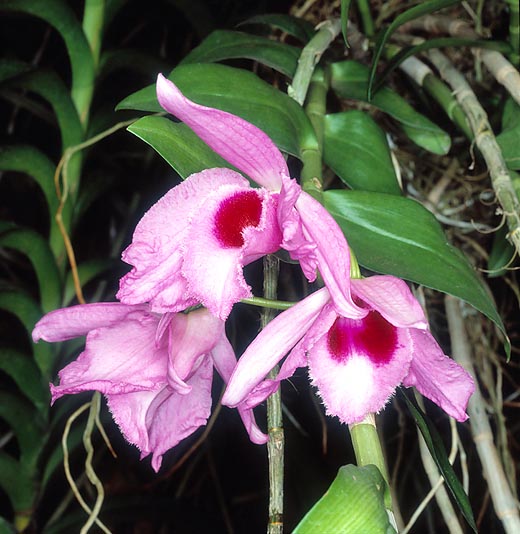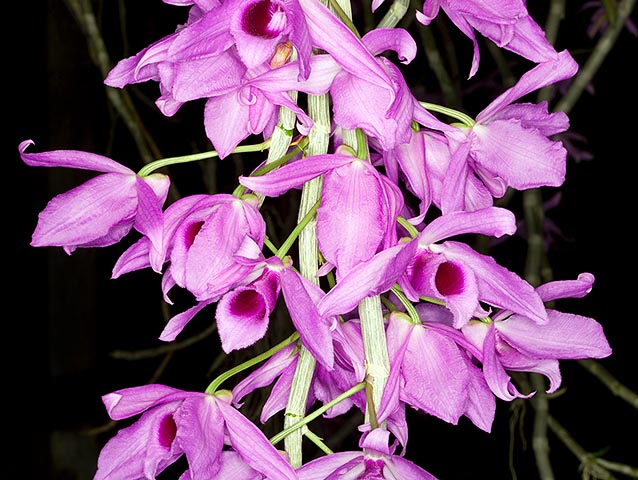Family : Orchidaceae

Text © Pietro Puccio

English translation by Mario Beltramini

The Dendrobium anosmum is a tropical deciduous epiphyte © Giuseppe Mazza
The name of the genus is the combination of the Greek terms “déndron” = tree and “bios” = life, with reference to the numerous species of the genus which live on the trees; the name of the species is the combination of the Greek prefix “a” = without and “osmé” = scent.
Common names: purple rain (English); hono-hono (Hawaiian).
The Dendrobium anosmum Lindl. (1845) is an epiphytic deciduous species with arcuate or hanging stems, knobbly, of 0,5-1,5 m of length and of about 1 cm of diameter and distichous, alternate leaves, oblong with pointed apex, 6-16 cm long and 2,5 cm broad.
The flowers appear at the nodes of the stems after the leaves have fallen, single or coupled, rarely more, have a colour going from the pink to the magenta with labellum purple at base, intensely perfumed, in spite of the name of the species; there is a form with wholly white flowers.
The sepals are lanceolate, 4-5 cm long and 1 cm broad, the petals are oblong, 4-6 cm long and 2 cm broad, undulate, the labellum is ovate with pointed apex, about 3,5 cm long, pubescent, with finely indented margins. It reproduces by seed, in vitro, by division and through the young plants which form after the flowering on the upper and lower nodes which have not carried flowers (in jargon “keiki”, which in Hawaiian means “sons”), which can be removed when they have formed a good radical apparatus.
It is one of the most appreciated species of the genus due to the rich flowering of relative long duration, 2-3 weeks between February and April, when the stems have no leaves, which presents some difficulty of cultivation if the alternation between dry and humid periods simulating what happens in the wild is not respected.
In summer, during the vegetative period, it requires a semi-shaded position, abundant waterings and fertilizations, medium-high temperatures and high atmospheric humidity, 70-85%.

The inflorescences form showy, long-lasting and even more than 1 m long cascades © Giuseppe Mazza
In autumn, when the leaves begin to fall, the waterings are to be reduced almost to suspend them totally, but avoiding to have the stems shrivelling, if needed, in order to avoid this, nebulising them periodically, the luminosity must be high, also with some hours of direct sun by day and the night temperatures to be around the 14-16 °C.
As soon as the new vegetation does appear at the base of the stems, the waterings and the fertilizations are to be progressively resumed.
For the waterings and the nebulisations are to be utilized rainwater, or water obtained by reverse osmosis or demineralised; the fertilizations, duly distributed in way to avoid salts accumulations, are to be done preferably with hydro-soluble balanced products, with microelements, at half dosage than what advised on the package.
It is cultivable preferably on suspended baskets, seen the drooping posture, with draining and well aerated compost which can be formed by a mix of medium sized bark, sphagnum, coir and fragments of charcoal, or mounted on pieces of bark or of branch with sphagnum at the base.
The species is inscribed into the appendix II of the CITES (species whose trade is internationally ruled).
Synonyms: Dendrobium macrophyllum Lindl. (1839); Dendrobium macranthum Miq. (1859); Dendrobium retusum Llanos (1859); Dendrobium superbum Rchb.f. (1861); Dendrobium scortechinii Hook.f (1890); Callista anosma (Lindl.) Kuntze (1891); Callista scortechinii (Hook.f.) Kuntze (1891); Dendrobium leucorhodum Schltr. (1912).
→ For general notions about ORCHIDACEAE please click here.
